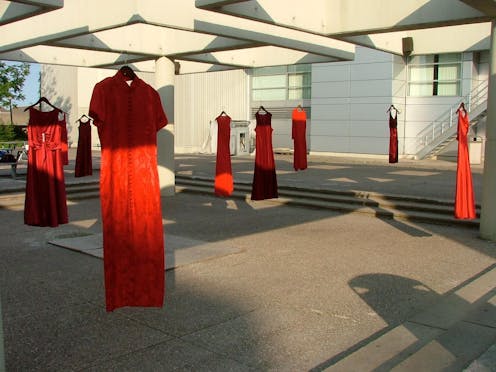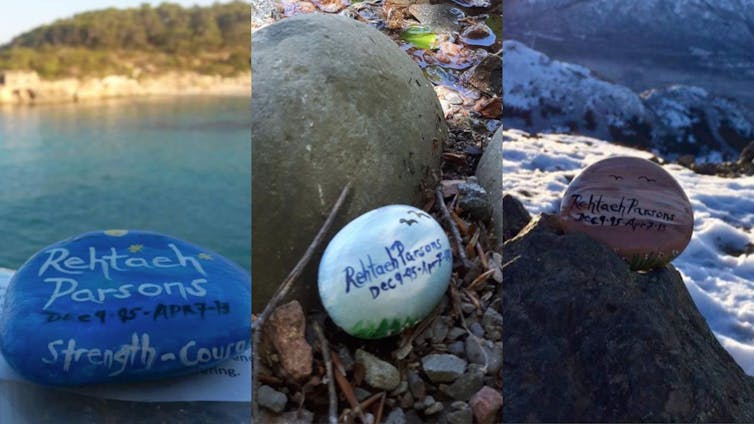
We’ve all heard of the #MeToo movement, founded by Tarana Burke. And in 2017, actress Alyssa Milano tweeted, “if you’ve been sexually harassed or assaulted write ‘me too’ as a reply to this tweet.” Her tweet sparked a whirlwind of social media posts that highlighted a gender-based violence crisis.
While hashtag activism and Hollywood are synonymous with gender-based violence advocacy, there are dynamic projects raising awareness across Canada. Métis artist Jaime Black’s REDress Project and Leah Parsons’ Memory Stones Project are examples of such creative and collaborative anti-violence efforts.
The REDress Project sees red dresses suspended where you would least expect them. Black is an artist-activist — or “artivist” — from Winnipeg, Man., who started the project in order to call attention to Canada’s Missing and Murdered Indigenous Women and Girls (MMIWG) crisis. The crisis has seen thousands of Indigenous women go missing or be killed since the 1970s.
In the Memory Stones Project, Parsons collects stones from the shores of the Atlantic Ocean, then paints them with bright colours and cheerful symbols to honour her daughter, Rehtaeh. Rehtaeh died by suicide after she was allegedly sexually assaulted by four boys and relentlessly victim-blamed. Each memory stone is hidden outdoors with a note that describes Rehtaeh’s experience. It urges anyone who finds the stone to “show kindness not hate” to survivors and “leave the stone” to share Rehtaeh’s message with others.

As the Government of Canada points out, certain people including “women; young women and girls; Indigenous women and girls; LGBTQIA2S+; transgender and gender diverse people; women living in Northern, rural and remote communities; and, women living with disabilities” are more likely to experience gender-based violence.
In Canada, one in four women report gender-based violence to authorities, while many cases go unreported due to fear of stigma and victim-blaming. Indigenous women in particular face gender-based violence 16 times more than white women in Canada do. They also experience more severe assaults.
After interviewing Black and Parsons for my research, studying their projects and speaking with people who engaged with them, what stands out is how both projects attract eager co-operation from everyday people — which is important for raising awareness.
When activists use materials that anyone can acquire, and invite citizens to co-create alongside them, it inspires people to jump on board.
Collaborative activism
During my conversations with Black and Parsons, they both mentioned being fed up with the normalization of gender-based violence, so they struck out on their own to address it. While these acts appear to be singular undertakings, they’ve both inspired impressive participation.
The REDress Project gained international attention, but its collaborative origins are little known. In 2010, Black called on Canadians to donate dresses and received over 600 garments. She told me that people have donated every dress she’s used since.
REDress-inspired projects regularly pop up. An Edmontonian started a “REDress Photography Project” in 2015, while Inuit installed a Red Amautiit Project in Nunavut in 2019. These creators, who were inspired by Black’s work, ensured first that she would be comfortable with them building on her idea. In fact, Black tells me she believes in “decolonizing the idea of art being exclusive.” She believes that this helps it “grow and evolve beyond its maker.”
Parsons’ Memory Stones Project also inspires engagement. After seeing memory stones on the Angel Rehtaeh Parsons Facebook page, people request stones so they can place them too.
Parsons tells me she’s painted thousands of memory stones to date, mailing them to people in “many places … Africa, China, Alaska, British Columbia, California, Germany, New Zealand, Dakar, Cambodia and more”. She instructs recipients to place the stone somewhere that speaks to them and send Parsons a photograph.
My interviews with people who have come across Parsons’ stones revealed that finding the stone helped them reflect on the importance of consent. By placing stones and sharing Rehtaeh’s story, people are helping draw attention to gender-based violence.
Replicability
These activisms’ uptake, in part, relies on the fact that they are easy to replicate. Black uses an everyday item, dresses, to raise awareness. Parsons uses stones, paint and varnish, which are easily acquired.
These projects demonstrate that with inspiration, people can use accessible objects and skills they already have to participate in anti-violence activism.
Black’s and Parsons’ initiatives were meant to inspire involvement. Black invites Canadians to hang their own red dresses to raise awareness and Parsons not only provides stones to people who request them, but encourages them to get involved through social media. On her Facebook page, she gives a blessing and instructions to those who want to paint stones at home and asks people to post photos online.
Because gender-based violence kills a woman every second day in Canada, it can feel overwhelming to try to address it. This is one of the reasons projects that are easy to participate in and reproduce, and that make people feel like they are part of a community that cares, are important.
This is an updated version of a story originally published on May 4, 2021. The earlier story failed to mention Tarana Burke’s name after the #MeToo Movement.
Nicolette Little receives funding from the Social Sciences and Humanities Research Council of Canada (SSHRC)
This article was originally published on The Conversation. Read the original article.







